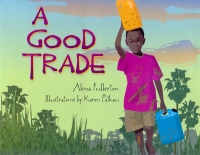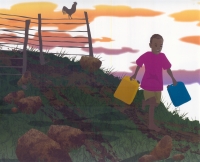| ________________
CM . . .
. Volume XIX Number 17. . . .January 4, 2013
excerpt:
As educators, we often tell our young students to look at the pictures when we read. The pictures reveal clues that will help us read the story and to better understand it. The images and text of A Good Trade complement one another to the point of poetic consistency. The text and the images are both complex and simple: concept easy, content load heavy. The prose is lyrical, playful and inviting to young listeners or readers with words such as “poppy” and “rut-filled hill”. Yet, there are potential story-stopping words too: “Jerry cans”, “borehole”, and “aid worker”. For every challenging word, however, there is a corresponding image, pictures simple enough to convey meaning and yet complex in colour and perspective. One image shows only the upper portion of Kato’s face as he peeks into the back of an aid worker’s truck to find many pairs of colourful shoes.
I thoroughly enjoyed this story from beginning to end. It will make an excellent discussion starter in social studies classes (as a supplement up to grade seven) and as a read-aloud in K-2. Highly Recommended. A children’s author, David Ward is an assistant professor at Lewis & Clark College, Portland, OR.
To comment
on this title or this review, send mail to cm@umanitoba.ca.
Copyright © the Manitoba Library Association. Reproduction for personal
use is permitted only if this copyright notice is maintained. Any
other reproduction is prohibited without permission.
NEXT REVIEW |
TABLE OF CONTENTS FOR THIS ISSUE
- January 4, 2013.
AUTHORS |
TITLES |
MEDIA REVIEWS |
PROFILES |
BACK ISSUES |
SEARCH |
CMARCHIVE |
HOME |

 The message of A Good Trade is equally daring. Author and illustrator have created a marvelous balance of apathy and respect. When Kato presents a rare white poppy flower to the aid worker, she honours his present with her own: shoes for all his friends. One of his friends is missing a leg. An allusion to soldiers indicates that war and trouble are constants in Kato’s village in Uganda.
The message of A Good Trade is equally daring. Author and illustrator have created a marvelous balance of apathy and respect. When Kato presents a rare white poppy flower to the aid worker, she honours his present with her own: shoes for all his friends. One of his friends is missing a leg. An allusion to soldiers indicates that war and trouble are constants in Kato’s village in Uganda.